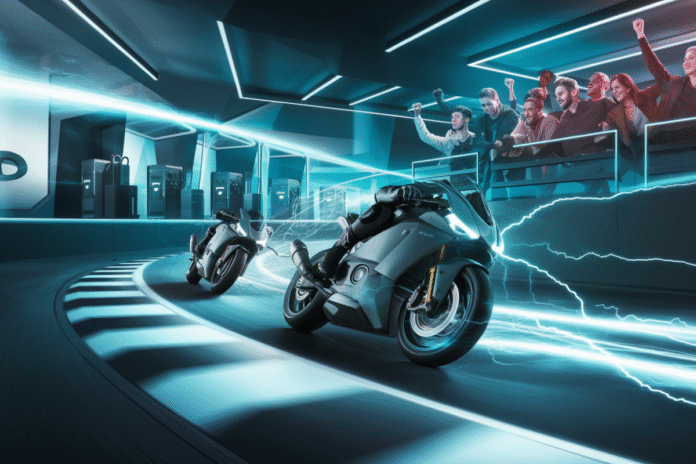“The future of electric racing is here.” This statement resonates deeply as the world witnesses a significant leap in motorcycle technology. The unveiling of the first solid-state MotoE bike marks a pivotal moment in electric motorcycle racing, showcasing advancements that could redefine performance standards. Solid-state batteries, known for their enhanced energy density, safety, and efficiency, promise to revolutionize how electric motorcycles are powered. However, just as excitement builds around this innovation, MotoE has announced a pause in its racing activities. This unexpected decision raises questions about the implications for the sport and the broader electric vehicle industry.
The stakes are high as the MotoE series, which has garnered attention for its commitment to sustainability and innovation, faces this hiatus. With the introduction of cutting-edge technology, the expectation was for thrilling races and increased fan engagement. Instead, the decision to take a break could hinder momentum in a rapidly evolving market. As manufacturers and fans alike ponder the future, the question remains: how will this impact the trajectory of electric motorcycle racing and its acceptance in mainstream motorsports?
Revolutionizing Electric Motorcycle Technology
The introduction of solid-state batteries represents a significant technological advancement in the electric motorcycle sector. Unlike traditional lithium-ion batteries, solid-state batteries utilize a solid electrolyte, which enhances safety and energy capacity. This innovation could potentially lead to longer ranges and faster charging times for electric motorcycles. For instance, while conventional batteries may take hours to charge, solid-state options could reduce this time significantly, making electric motorcycles more appealing to a broader audience.
Recent studies indicate that solid-state batteries can achieve energy densities exceeding 500 Wh/kg, compared to about 250 Wh/kg for current lithium-ion batteries. This leap in efficiency not only promises better performance but also addresses one of the significant barriers to electric vehicle adoption: range anxiety. As manufacturers strive to develop these technologies, the implications for racing are profound. Faster bikes with longer ranges could transform the dynamics of competitive racing, offering thrilling experiences for both riders and spectators.
The implications extend beyond performance; they touch on the environmental impact as well. Solid-state batteries are generally considered safer and more sustainable compared to their predecessors. As the world increasingly prioritizes sustainability, the adoption of such technologies in racing could pave the way for broader acceptance of electric vehicles in everyday life. However, the recent announcement from MotoE raises concerns about the timing of these advancements and their integration into competitive racing.
The Impact of the Motoe Hiatus
The decision to pause MotoE racing comes as a surprise to many in the industry. Initially, the series aimed to capitalize on the growing interest in electric vehicles and showcase the potential of solid-state technology. However, logistical challenges and market conditions may have prompted this unexpected break. The hiatus not only affects the series but also raises questions about the future of electric motorcycle racing as a whole.
During this pause, manufacturers may face challenges in maintaining momentum in their electric racing programs. The development of new technologies requires continuous testing and refinement, and a break in racing could slow down these processes. Additionally, sponsors and fans may become disillusioned if the series appears stagnant, potentially impacting future investments and interest in electric motorcycle racing.
This situation also highlights the broader challenges within the electric vehicle market. While the technology is advancing rapidly, the infrastructure to support widespread adoption still lags behind. Charging stations, battery recycling programs, and consumer education must evolve alongside technological advancements to ensure a smooth transition to electric racing. The MotoE hiatus may serve as a critical juncture for stakeholders to reassess their strategies and reinforce their commitment to the future of electric motorsports.
Future Prospects for Electric Motorcycle Racing
Despite the current challenges, the future of electric motorcycle racing remains promising. The development of solid-state batteries is just one aspect of a larger trend toward electrification in motorsports. As manufacturers continue to innovate, there is potential for a resurgence in interest and participation in electric racing. The key lies in how stakeholders respond to the current hiatus and leverage the advancements in battery technology.
As the industry navigates this transitional phase, collaboration among manufacturers, sponsors, and regulatory bodies will be crucial. Establishing clear guidelines and support structures can help foster a robust environment for electric motorcycle racing. This includes investing in infrastructure, promoting awareness, and ensuring that racing remains an exciting and competitive platform for showcasing new technologies.
Moreover, the lessons learned during this period can inform future strategies for electric racing. By addressing the challenges head-on, stakeholders can create a more resilient framework that not only supports technological advancements but also engages fans and attracts new audiences. The potential for electric motorcycle racing to become a mainstream motorsport hinges on the collective efforts of the industry to adapt and innovate.
Embracing Change in the Racing Landscape
The MotoE series serves as a microcosm of the broader changes occurring in the racing landscape. As traditional motorsports face increasing pressure to adapt to environmental concerns, electric racing presents a viable alternative. The introduction of solid-state technology could position electric motorcycles at the forefront of this evolution, appealing to a new generation of environmentally conscious fans.
However, embracing this change requires a shift in perception. The racing community must recognize the potential of electric vehicles to deliver thrilling competition while also aligning with sustainability goals. Engaging narratives around innovation, performance, and environmental responsibility can help reshape the image of electric racing and attract a diverse audience.
Ultimately, the future of electric motorcycle racing hinges on the ability of stakeholders to navigate the complexities of technological advancement and market dynamics. As the industry stands at a crossroads, the decisions made during this hiatus will have lasting implications for the sport and its role in the broader motorsports ecosystem.


